Written by Terry Smith
Our site is reader supported so when you click a link to Amazon we may earn an affiliate commission.
UK’s best electric fence sprayer [TESTED] for Cuprinol and Ronseal
This article was last updated on March 6th, 2023 at 11:11 am
Electric fence sprayers make light work of a tedious job, I wish I bought one sooner – if you’re looking for a manual garden sprayer though, please follow the link provided as they are equally useful for thinner stains and treatments, probably better, but if you want to spray paint, read on! I tested the best fence sprayers and found I can spray a 5ft panel in about 2 minutes, maybe a bit less, and I can spray a 4ft panel in about a minute without pushing myself IF I thin the paint right down so it requires multiple coats – on the other hand the Wagner Fence & Decking Paint Sprayer takes about 4-5 mins a panel but only needs two coats even on bare wood! That’s not watered down and wishy washy either, this is Ronseal one coat fence life and in my test today, the Cuprinol ducks back fence paint which is like tar 🙂 ! Hard to believe I know, I was shocked by the commercial performance with a low price tag myself. I never get tired of using these sprayers 😀 Here’s a look at the top three best electric fence sprayers that made it to my tests in the UK but by miles the Wagner wins and is almost untouchable:
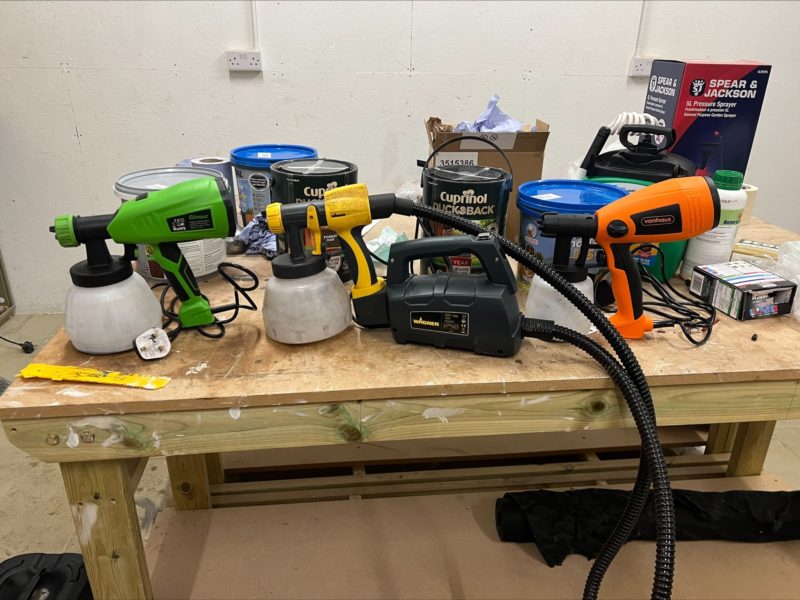
As you’ll see though, electric fence sprayers aren’t all even and the Wagner was the real standout:
PRO TIP: Please, please before buying an electric fence sprayer ensure that you have a good mask and read the spraying safety instructions carefully. Your lungs will not thank you for breathing in fence paints, paint and wood preservatives in particular. These electric fence sprayers will allow a fine mist so be careful which I avoid if you check my videos. Here’s a look at my mask after spraying a couple of panels so you can see what I kept out:
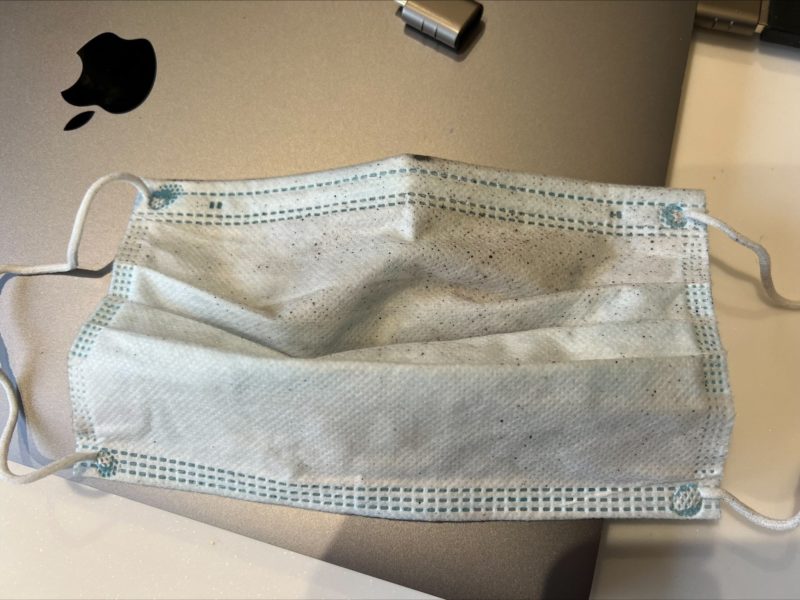
I found out something interesting too as I tested multiple electric fence sprayers – all the research and reviews you read online is anecdotal based on just one test. If those reviewers or researchers had a few in their hand like I did, they would be able to draw genuine conclusions. The real answers are in the testing. For example. The paint sprayers Ginour and VonHaus are decent enough in their own right, but as a fence sprayer they are no where near the capability or comfort compared to the Wagner fence sprayer. You’re probably thinking that’s a bold statement to be making about products online. Well, after testing, I can definitely make that assertion and here’s a look how I genuinely rate them after personally testing extensively:
Best fence sprayer in the UK: my top picks after full testing:
Best fence sprayer: Wagner Fence & Decking Paint Sprayer – fully tested and easily the best of the best in the UK, indisputable but feel free in the comments below 🙂
Most powerful: Wagner – tested and proven
Best budget: VonHaus Electric Paint Sprayer for Fences – if you really need to save twenty quid take a look at the Vonhaus – and was better in terms of less overspray
Best for a large area or shed: Wagner Fence & Decking Paint Sprayer
Best you can use on multiple surfaces: Ginour – if you want a tool for multipurpose use and don’t mind being slower than the Wagner (or heavier on your back) this will be good all around the home.
What you should consider when buying an electric fence sprayer
From extensive testing I noted a few potential benefits and pitfalls well worth discussing with you before you take the plunge. The biggest things for me are to do with the capabilities and ease of use. Some are capable of blasting fence paint with no thinning, just fill and go, while others are so clear about their ability to spray/viscosity that they have a funnel test timer to make sure it’s runny enough. However, the most powerful blast paint so hard it might be described as Artex 😀 This means not so good if you fancy cleaning up your electric sprayer and using it on door frames and walls etc.
Paint viscosity requirements
So when you research online you’ll see that the Cuprinol Ducksback, and Ronseal fence paints want a bit of thinning. And to be fair if you pick anything except the Wagner then this is definitely the case. Those sprayers come with a paint viscosity tester – you’ll notice the Wagner doesn’t have this which at first threw me, but soon became clear. Basically the Wagner can push through anything paint wise that is produced for fences and could also be called commercial – pretty shocking given the low price tag.
On the other hand the Ginour and Vonhaus spend a fair bit of time in their manuals showing you how to test if the paint will spray – I decided to see if they were better than advertised but no, they couldn’t push the same thickness paint as the Wagner. Here’s a look at that paint tester:
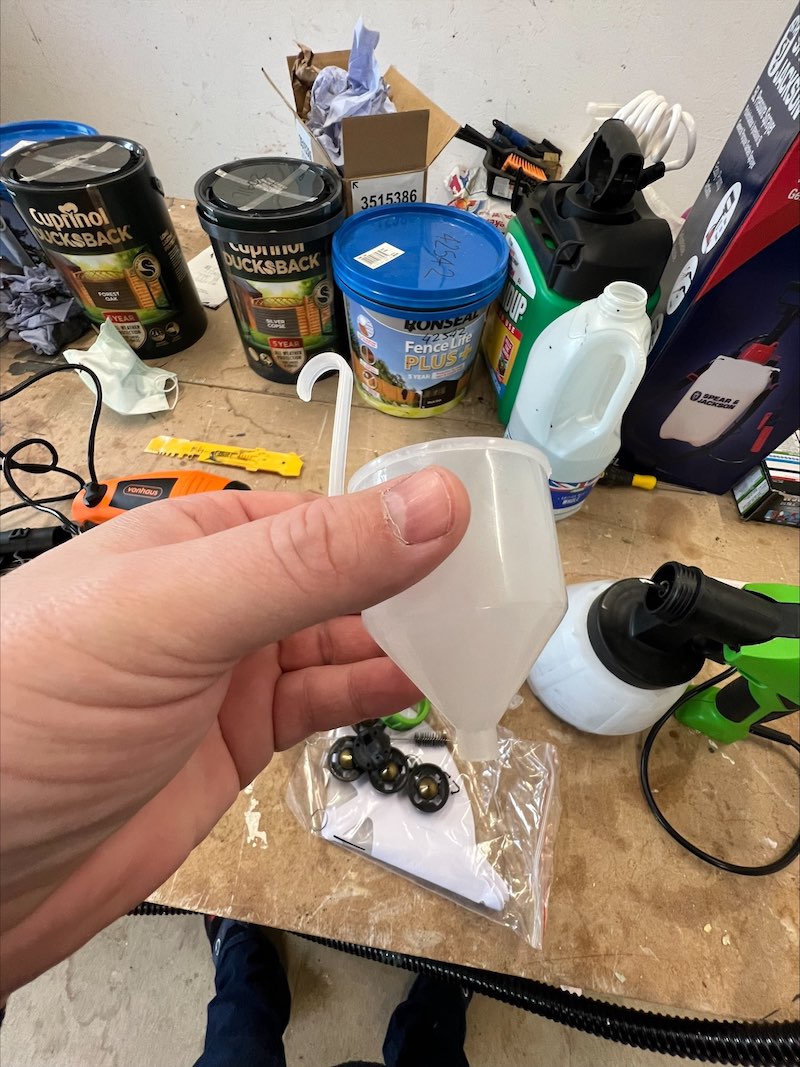
And here’s a look at the bore size – amazingly Cuprinol Ducksback and Ronseal life plus do not flow through this! Talk about non drip for real:
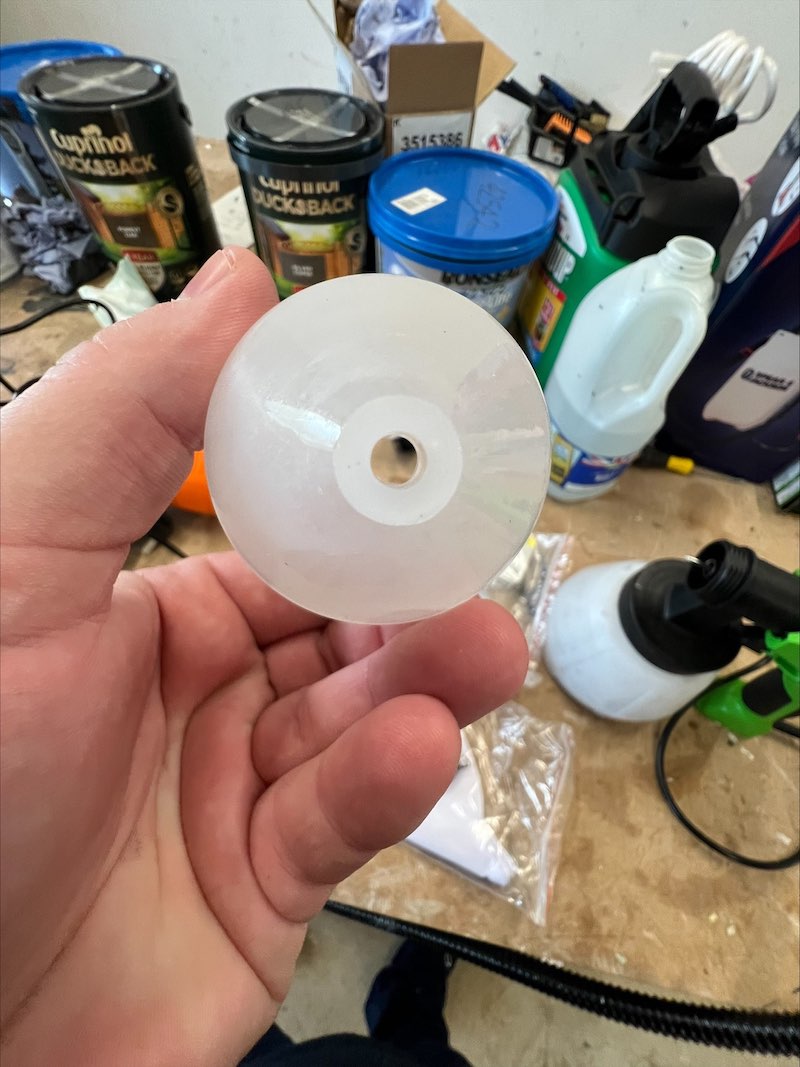
Assembly
The one thing that these sprayers all have in common is just how easily they assemble. If you take a look at the Wagner, Ginour, or VonHaus then you can see I’ve put you a really short clip showing assembly. The Ginour even comes with a bit of vaseline or grease around the connection to make it slide together easily. We are talking a maximum of 10 seconds! The Vonhaus is exactly the same method with a lock to stop it coming apart but they’ve missed the grease and therefore requires far more force, something that will bug you even if you didn’t know the Ginour is so much better! Here’s a look at what I mean about greasing the slide together sections:
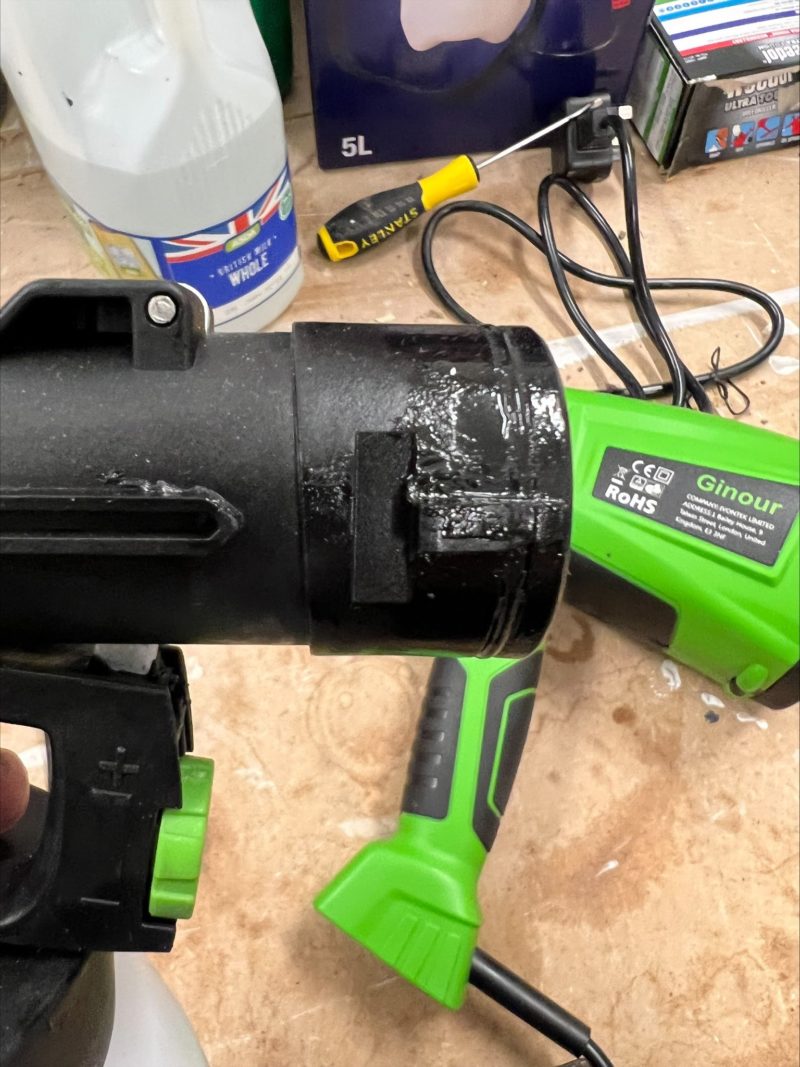
Here’s a look at comparing the assembly on all three units:
Some electric fence sprayers will hurt your back on a long run
So something I learn’t from testing very quickly was the weight on your back. When you factor 1.4 litres of fluid on top of the weight of the Ginour, which weighs 1.7kg it really does begin to pull on the back. While the Vonhaus has a smaller paint pot and weighs less, it still becomes arduous. Meanwhile the Wagner which is a mile ahead of the curve on this has the engine detached with a long air feed (see more about that in the full review) and so actually despite being the heaviest overall, is the easiest to use. They really nailed that for people with a bad back, trust me on that from hours of testing!
How quickly will it spray fence paint
They are all pretty good, it just so happens that the Wagner is warp speed compared to the other sprayers. Even laying on what you might call two coats takes less than a minute for a short fence panel with the Wagner. In case you didn’t watch the clip, here it is again:
To check the performance of the other guns please take a look at their reviews, you may like me realise they are not as good, but prefer them over the Wagner noting you’ll be able to find other uses for them (walls, ceilings, skirtings, etc)
Do they clean up easily
I have to say it was very surprising and enjoyable to clean up – being all water based (except the Creocote which I’ve decided is much better applied with a standard manual garden sprayer. For the most part, if you don’t let the paint dry you’ll simply disassemble the unit and turn on the hot tap. A couple of minutes and you’ll be good to go next time – don’t get lazy on this or you’ll have a real job on your hands if you ever want to use that sprayer pot again:
I know from the past where I’ve had a beer, I can often completely forget what I should be maintaining 😀 But an electric fence sprayer is seriously unforgiving if you don’t clean it up straight away!
Overspray and masking up
One thing to watch out for is overspray. Definitely as my picture above shows this kicks paint up in the air and you don’t want to breathe it in. Now imagine how much worse that would be with wood preserver or Creocote so if you intend to do so, make sure you have proper masked protection for poisons – literally. This short video clip highlights just how much overspray we are talking about:
With the paint itself though, on a practical level you really want to mask up and tape any areas that are vulnerable. The only thing I didn’t enjoy about the whole process was the overspray. Here’s a look at me tapping up and trying to protect the fence posts and gravel boards:
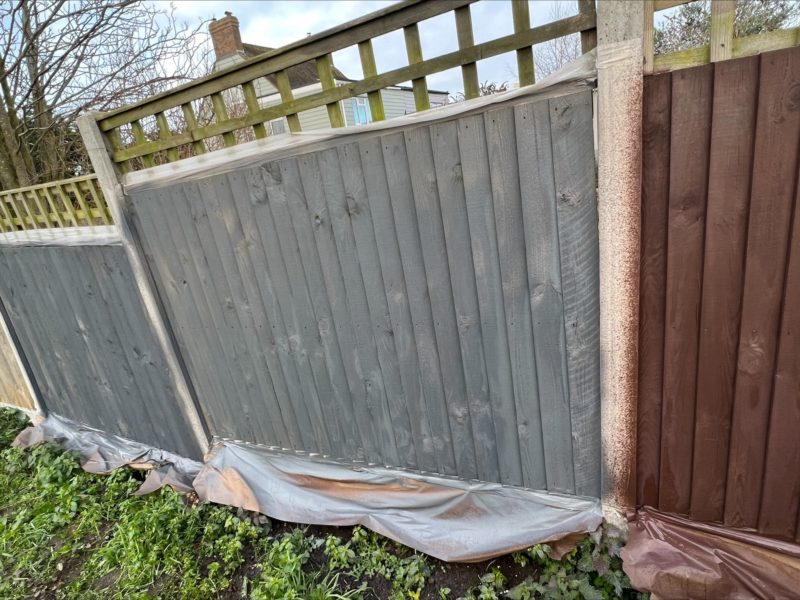
Now obviously try not to spray over the neighbours fence – I was careful near the top and gave myself 4 inches with two lines of duct tape – if your sprayer is clean and firing properly then that is manageable, even with the more powerful Wagner.
1. Wagner Fence & Decking Paint Sprayer for fences
Update since buying the Wagner fence sprayer 18 months ago:
I’ve used the Wagner about 50 or so times now. Each time I get more impressed. Even on a fence panel that has never been painted, it can easily push through thick Cuprinol Ducksback that is either marginally watered down, or not at all. The big con is videos showing it emptying pots in a minute or two. As I now realise this is because the paint has really been watered down. I’ve separated out my original review so you can see how I feel about this sprayer and what I’ve learned over the time. The differences are not for you just to assume I have contradicted myself 😀 but actually see how using this electric fence sprayer over time has evolved my opinion and advice from continual use and testing:
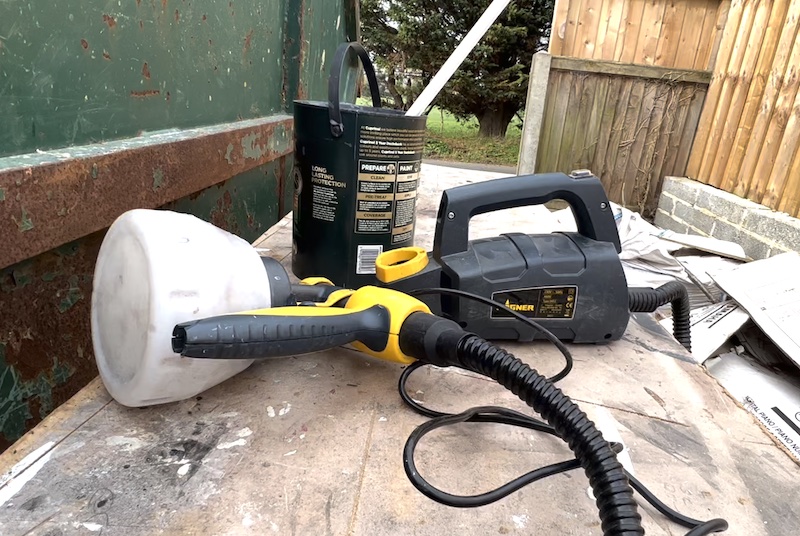
So, my preference these days is to push it through really thick, and whilst the engine heats up, it can more than handle it and then even a fence panel that has never been painted choosing a light colour only needs two coats – it’s fine as you can see in my earlier video with dark brown that covers easy but lighter colours need thicker paint and more coats. So with the ability to push through thick paint, it really is miles ahead of the rest and for good reason outsells all the other fairly well priced competitors by far. Here’s a little look at me using the Wagner and giving it another thorough test:
One main point I would draw you to. I like to use the dense spray because the mist is far more airborne and you breathe much more paint as a result. Definitely worth wearing a mask whatever setting you choose even if outdoors. And if you go for something like Creocote and don’t wear an FPP3 Mask you will feel physically sick as I have made that mistake. As you can see from the quick demo it’s miles quicker than hand painting and aside from how I slop it in the pot, if you take your time quite a clean process. I don’t bother taping up the block beneath as that’s being rendered soon (hopefully) 😀 but you definitely should lay some old cardboard and mask up with newspaper anywhere you want to keep clean. HEre’s a look at my mask after half an hour:

Apart from that keep your nozzles clean and this thing just keeps on going as the latest video above demonstrates.
Old review from 18 months ago but still relevant:
Wagner Fence & Decking Paint Sprayer is a far far better bit of kit than the cheapest sprayers which is why it’s my choice for the best electric fence sprayer. OK you pay a few quid more, but this thing genuinely covers a fence panel in 3 minutes – as you’ve seen in my demo above quicker still if you lift your panel out. Let’s assume you have a long fence, this thing saves the wages you paid day 1 and the tool is free forever more. It’ll fire out paint as well as treatment. So it can handle a heavier workload than your wood preserver or Creocote. Many use it for painting garden furniture too with excellent results – I will do so as it warms up. Here’s a little demo of just how good this thing is in conjunction with me spraying Ronseal one coat:
It’s not just good on fence panels either, in my mind it’s even better on larger surface areas. Watch what this can do to a 6m long shed in a few minutes. Granted it needs a second coat but the performance is outrageous! Watch this on the best shed paint, Cuprinol ducksback (note I thinned this based on what I read online at the time):
Watch the overspray though – unavoidable with any sprayer but if you have neighbours or something that can’t be painted close by then factor in how to protect it. Sorry about the samera angle I am still getting to grips with this gopro but I think it shows enough. If not, worth taking a look at how it handles Ronseal too:
I like the pot size at 1.4 litres – it is plenty enough for anyone and will get around both sides of a panel without refill just about – but this depends how thick you spray though – I aimed to have my Cuprinol Ducksback and Ronseal Fence Life Plus Paint (the multiple coat kind) finished in two coats so got quite close to running out on 4 and 5ft panel. The one coat from Ronseal really is one coat in this sprayer. One thing that annoyed me about all of these sprayers though, I couldn’t quite lay the paint in the pot with a ladle as it’s so thick it bulges outward to the sides – this will bother you too. If I was organised and knew I didn’t intend to brush this paint on at some point I’d maybe thin it down then add. Talking of thinning, that was part of the problem. I had read online you need to thin the Cuprinol. Well you do, with all sprayers in this review EXCEPT this one. This is by far and away the most powerful of all in this review.
It’s easy to hold too. The strap to hold the motor is a nice touch and makes this thing easy to use and let me tell you just how much my back began to ache when I held the Ginour and Vonhaus. Having the motor connected to the pot and holding the weight outward to keep yourself away from the paint a bit is HEAVY. That’s why you’ll see people using two hands on other sprayers, not this one though, miles ahead of the pack for comfort on the back. Regarding the motor and strap, the more I used this, the more I started to carry the motor or place it on the floor as it’s so light and allowed for so much more speed. The air feed tube if quite long – about two metres and you can see that well from my 6ft workbench. Let’s take a look at what I mean here:
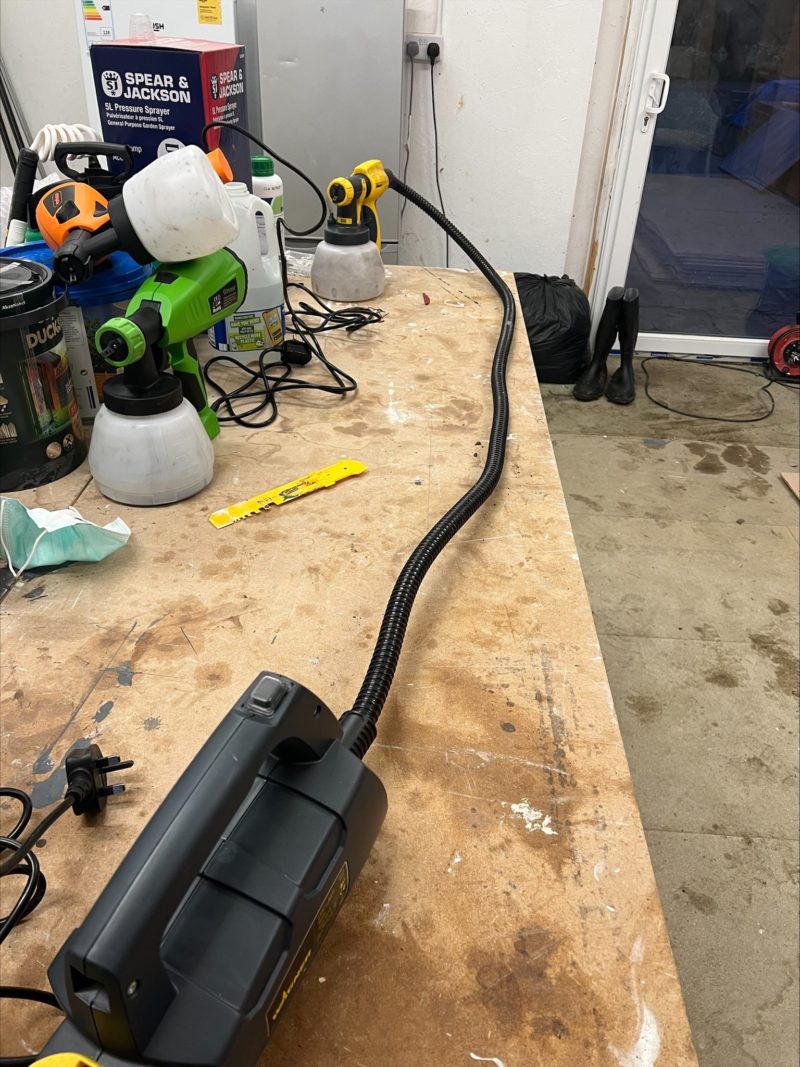
Well, easy to use within the bounds of a power cable. A nice touch was the ability to set the sprayer both horizontally and vertically. This is particularly helpful as I sometimes (depending on the power cord reach) changed my angles up so having the sprayer change for me made holding it comfortably all the easier. The extra-fine atomisation provides you with pretty good coverage not that you’re worried about that on a fence! However, I set mine to a thicker spray as I didn’t want to breathe all that in. And despite that, I still got a mask full. Please see the picture and warning at the start of the article for that.
In terms of better than this, if you want a cordless solution then you’ll need to drop 5-6 times the money and buy batteries too though. This is double the price of the cheapest but in my mind easily ten times better so that makes it a bargain and there are very few failures and returns on this particular model. It’s been reliable for hours of testing. I tell you one thing though, the Cuprinol coagulates quickly inside the sprayer in hot conditions, so if this stops spraying you can bet it’s a clog from paint setting, and not the sprayer performance. I can guarantee you that from experience which will save you time getting worked up.
Setup is a doddle. Here’s a quick video demo of that, it’s no exaggeration to say you’ll be up and running in 30 seconds. I will say though, the Ginour was even more impressive for that, despite not being as good overall – let’s look at how easy that setup really is.
And also that video reminded me of another good thing about this unit. With the motor being separate from the paint pot, there’s no weight pulling down as you tighten up and re-attach the pot to the sprayer, as a result, it doesn’t mis-thread which was a common problem on the other units I tested.
In terms of what this sprayer can be used on – pretty much everything. Paint decking, fences, windows, and garden furniture will be no problem. You can use it with water based wood or solvent and metal paints including wood preservatives, satin, gloss, stain, varnish, undercoat, fence paint and decking oil.
No tool is without its flaws though, on testing I found the nozzle (age old problem with all sprayers) needed cleaning or it began to spurt. This was with Cuprinol Ducksback in particular (you can’t knock a product for setting quickly as you want), not with a fence treatment like Creocote though, that’s very watery and flies through. If you try to be cheap and buy the Wagner Vonhaus or the Terratek then be warned. I told you so. This is THE KIT for electrically spraying fence panels at fair money with no hassle and to summarise:
– Not the cheapest but definitely the best electric fence sprayer on a budget
– Can paint a fence panels in a few minutes VERIFIED and personally tested.
– Big pot – holds loads of treatment or shed stain
– Very few failures
– Wagner has excellent customer service if you do need help
2. VonHaus Electric Paint Sprayer for Fences
Vonhaus started making pretty good garden tools over the last few years. So I thought I’d include them in my test – that and they are top rated so I wanted to see what was going on here. I’m going to be straight up honest off the bat, this is not my best pick for a fence sprayer in the UK because Wagner has this covered. And my opinion is the Ginour is better than this at the price point but don’t write it off if you like a two year warranty. They advertise it as a paint sprayer but in truth, it’s much better classed as all rounder, so a Jack of all trades after my testing and will need to be added to the best paint sprayer article. It has the usual vertical and horizontal spray that you’re probably becoming familiar with as you read the entirety of the review. One thing I did like, is the evenness of the spray. Unlike the Wagner which forced out massive pressure and huge amounts of paint, this was more delicate and so resulted in less overspray – something worth considering. Here’s a look at how you’ll get on with this:
When you’re using it (assuming you’ve used other paint sprayers like this before, you’ll note this unit is lighter than the Ginour and feels better on the back – as a result I think it pushes less material than the Ginour but not a problem in my mind when factoring the two year warranty too and the fact it sprays very evenly does weigh in favour too. There’s really nothing of note on these, they are literally plug and go. You’ve got your viscosity kit to check the paint will flow through nicely, and on the gun you’ve got an adjustment for the amount of spray, more useful for paint spraying than fence as you want the fence spray on full blast:
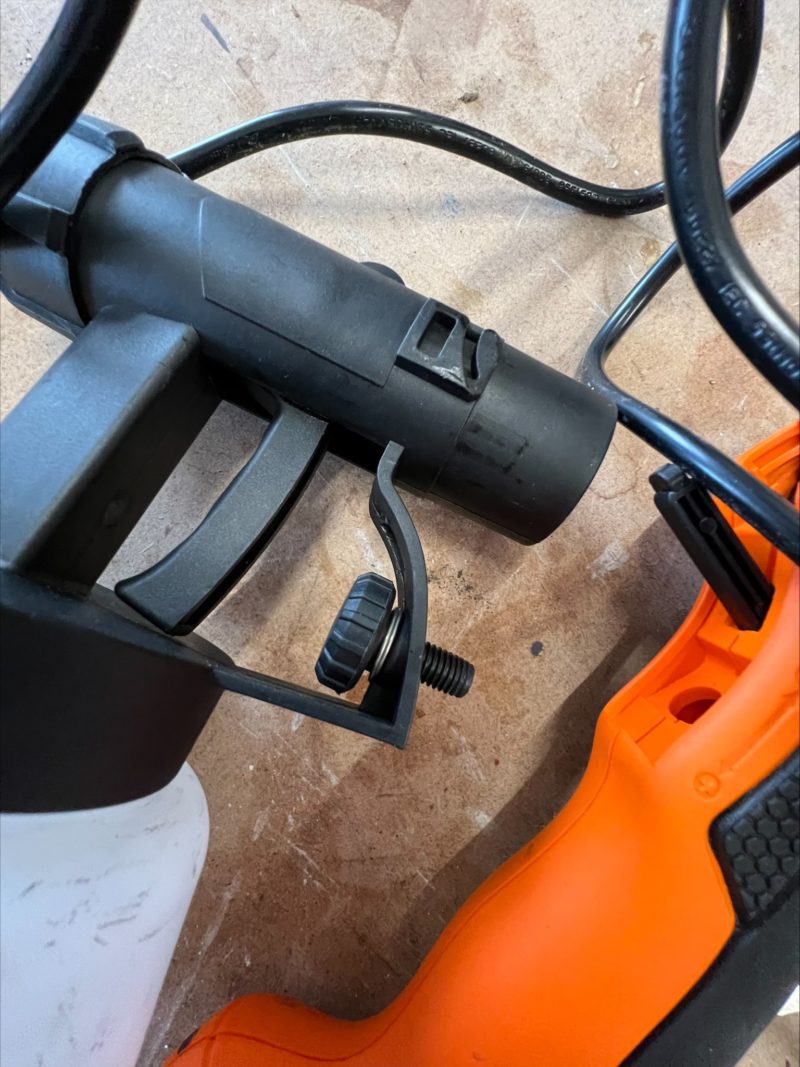
You’ve also got the lock mechanism that binds the spray pot to the motor – this is a problem for me as it’s too stiff to put together and pull apart:
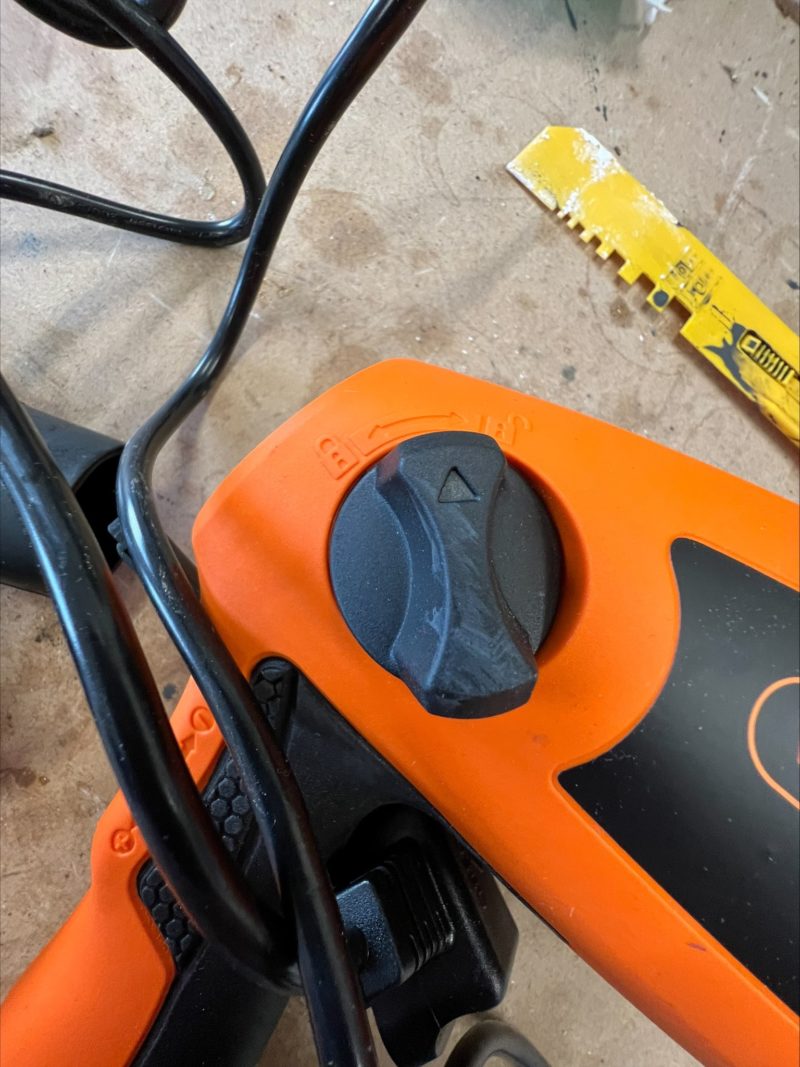
Apart from being stiff, it easy to setup and use like the other sprayers and handles well enough – what will enrage you though if you’ve had the fortune of assembling the Ginour is just how tough the Vonhaus sprayer is to put together – and take apart – check my assembly video. Filling and pot attachment is all pretty straight forward too. This particular model has a lot of bad feedback and it is absolutely aimed at paint spraying, not fence spraying. As a fence sprayer this is a good bit of kit and well priced.
Overall, my feeling is Vonhaus are trying to do too much for £40 quid. My compressor and sprayer setup is £5000 and I still have blockages and grief in the workshop when spraying. If I were them I would rethink the target of this product because as a fence sprayer it’s slow but pretty much faultless . It’ll coat just as fast as the Mertek, cleans just as easily and in general pushing this as a specialised paint sprayer isn’t quite right, it’s definitely an all rounder.
All in all a good buy but I prefer the Ginour though more expensive, to recap:
- Cheap electric sprayer
- Good feedback online as a fence sprayer
- Easy to clean nozzle
3. Ginour Fence Paint Sprayer
Quite an impressive all rounder. That’s how I will sum this one up but not as good as the Wagner. Bold statement you think? Well for a start it can’t handle Ronseal or Cuprinol out the tin without thinning whereas the Wagner can. And that means more coats – which adds up to a longer process getting the fence painted. However, where I’d say this thing wins big is the versatility. Bear in mind you’re not just buying a fence sprayer, but an electric paint sprayer that can do a fair bit around the home and garden – it might just sway you to take a jack of all trades rather than an out and out fence sprayer.
Let’s start with the big plusses. Out the box this thing clicks and is ready to use in literally 10 seconds. Here’s a look at that:
Once you’ve loaded up with paint it’s all go. Don’t waste your time trying to push Ronseal or Cuprinol through this without thinning – I already tested it and it doesn’t work – but thinned to the viscosity they stipulate, it goes just fine:
So one of the biggest drawbacks to using this sprayer is the 3kg it weighs when your arm is fully extended and the paint pot full. Obviously holding more paint than the Vonhaus is a good thing, but it comes at a price. I really wanted to get to the end of that panel if I am honest as it’s a fair weight on your back, granted I was leaning over too, but I can easily see this becoming a two handed operation on a long line of fence panels!
To sum this up in terms of ease of use, the machine itself is pretty much a hairdryer that sprays out paint, it really is that simple. There are a few nozzle bore variations though, which is why I say this is a much better all rounder as you’ll be able to spray paint with this after, not just your fences and sheds – this is obviously just as useful on shed paint. Here’s a look at those variable nozzles:
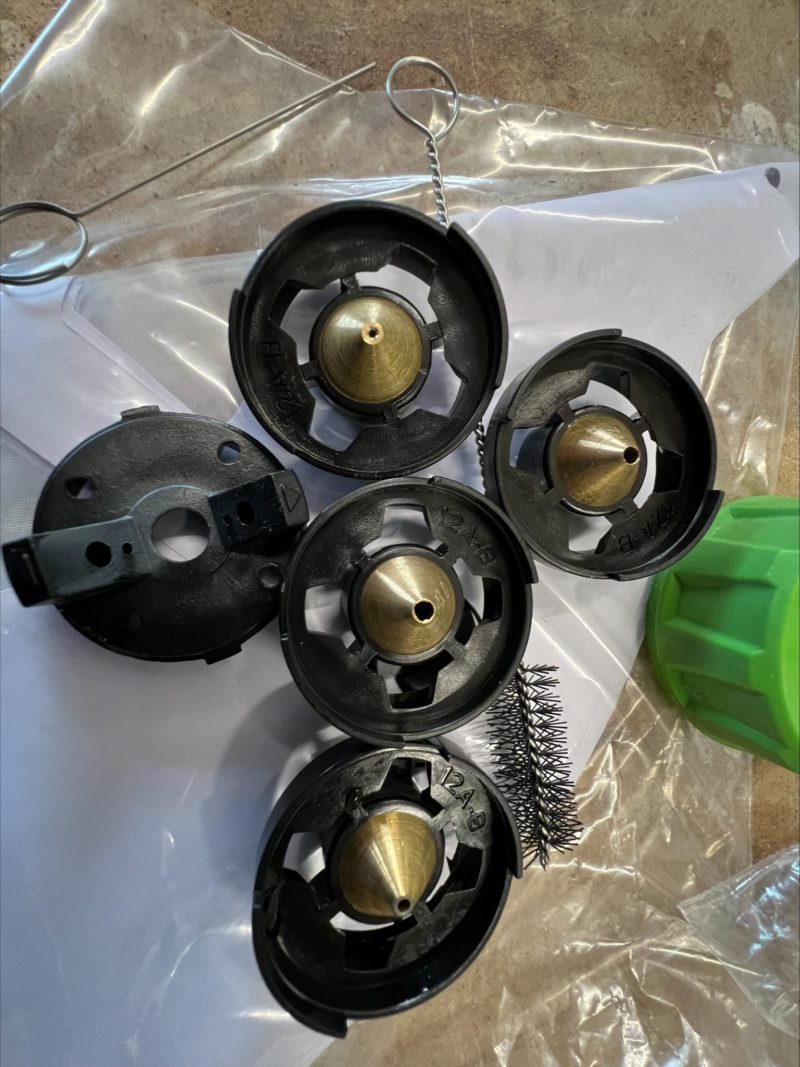
Like the Vonhaus you’ve then got an adjustment on the trigger as well as the lock for the pot – this time it is placed above the machine and it is far easier to remove as they have added a little grease or vaseline to the bore tube to help it slide together without sticking:

Overall I would say I prefer it over the Vonhaus but it’s a real coin flip – I’ll update this once I’ve thoroughly tested it out as an indoor and outdoor paint sprayer as well. But for fences alone, I still have to say the Wagner rules the roost!
4. Meterk Paint Sprayer, Electric Spray Gun
Like the Wagner the Meterk is a HLVP. If you’re unsure what that means, it’s basically an air compressor that feeds the paint or in our case fence paint or treatment. It’s a minified version of full on spraying that you will see for cars and joinery.
Minified shouldn’t scare you though, the Meterk is a 400 watt sprayer and easily capable of dealing with the fence panels and shed. It’s very similar in setup to my favourite the Wagner, but you could probably say it’s a smaller version of it. It has the vertical and horizontal spray, a smaller motor for the compressor, a smaller pot at 0.8 litre and the parts detach easily for cleaning. They advertise this on the basis of praying paint. That I think is our advantage, fence paint and treatment is much thinner and passes much more easily so this is a bargain in it’s own right for fence spraying.
Don’t take the smaller than Wagner the wrong way either. It’s easy to setup and well designed. This is probably a benefit to someone looking for as lightweight electric fence sprayer as possible but with a decent price point and performance. This thing will still sort out a long fence in a couple of hours and weighs less making it my second choice for best electric fence sprayer.
As with all sprayers from DIY to spraying cars; keeping the nozzle clean is a must and Meterk have done well to make the spray nozzle easy to remove. If you go through online reviews for sprayers, 9 times out of ten a decent sprayer will have negative reviews ‘not working after the first use’. Well there you go – clean your nozzles if you want a tool to last more than the first use so put that five minutes in at the end for your own sanity!
- Lightweight and plenty of power
- Fast for spraying fence panels
- Well built
- Detachable nozzle for easy maintenance and cleaning
- Must be cleaned after use
5. Tacklife Paint Sprayer SGP15AC Spray Gun
The TACKLIFE Paint Sprayer feels like a very similar spec to the Vonhaus, and as I get feedback from my customers it always feels the same. If you buy this to spray thin treatments and fence paints then it’s five star. Then you have the crowd that think they are going to fire Dulux super thick, super matt for 50 quid. Total Lala land but actually I don’t blame them, much is to do with the companies making these tools to manage expectations. Perhaps they think budget tool buyer means budget watery thin emulsion buyer. Kind of stands to reason I guess but no, the TACKLIFE Paint Sprayer will not shoot out Dulux trade super matt in an efficient and satisfactory manor in my opinion. If they are reading this review and want to challenge my opinion I am open to it. However, after testing I know it does not…but I will say it’s better than the Vonhaus for paint in my mind you just need to watch your viscosity.
What it does do however, is a great job of fences and as an electric fence sprayer its a pretty good bit of kit. I would probably go with the Vonhaus as it’s a tenner cheaper as I write this in Feb 2021. With two years warranty, and the 400W motor I do think it’s a buy, or it would not have made the review! I also like the extra paint fill screw cap on top. If you have a funnel then it saves the normal mess you make from entirely unscrewing the pot.
- Easy to fill paint pot
- Sprays fences nicely and fast
- Relatively cheap
6. NoCry Electric Paint Sprayer
For me the NoCry Electric Paint Sprayer is a better buy than most in the £50 range as it has a 600 Watt motor and bigger paint pot. Most notably they believe in their product with a full 4 year guarantee. This is a longer guarantee than most top known brands so props to them on that. This isn’t a company around for 5 minutes dumping warranties either. They have made literally tens of thousands of sales and have the same number of reviews online.
Specifically for this sprayer it’s great on fences. The reviews for fences almost always come out five star. As for painting, it’s pretty good too as long as you are using the right viscosity of paint.
- It comes with a 600w motor.
- 1000ml paint container.
- Well prices
- It has a detachable design for easy clean like other models
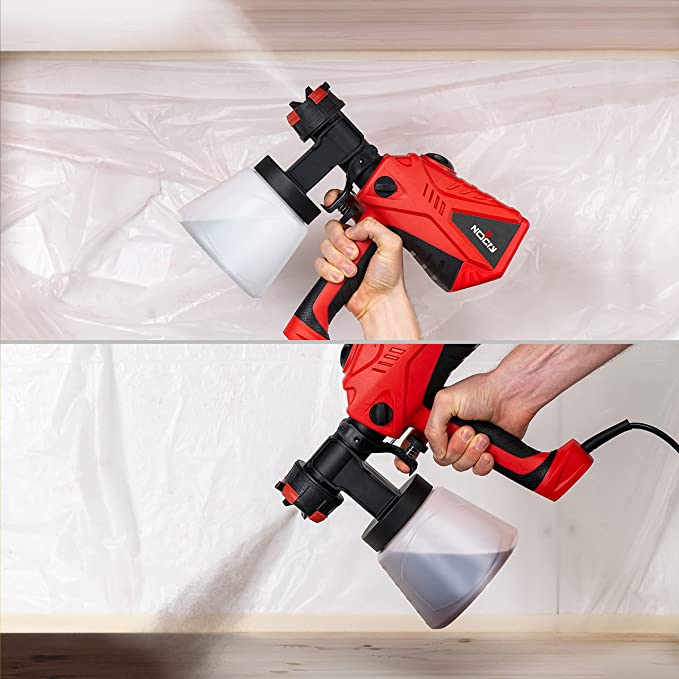
7. Terratek Paint Sprayer, 550 DIY Electric Spray Gun With 3 Spray Patterns
The Terratek Paint Sprayer, 550W DIY Electric Spray Gun with 3 Spray Patterns claims to be 8 times faster than conventional brushing. What I found from testing is that is actually an understatement. I have no idea who they had painting to keep up but a fence panel takes me a good hour or so unless I slop creocote about like its water. And that it most certainly is not. It’s nasty stuff. So time wise this thing does the job miles faster. I’d say I rip through a panel in a good ten minutes or less.
From a price perspective it’s cheap. Don’t be buying this thinking you’re going to lay on Farrow and Ball in your hallway. This thing is a cheap jobber tool for slapping up the fence. That’s after all why you are reading this review. It’s a bit splashy and splurgy. But for a fence it makes sense. It’s got a bit of a chequered history if you look online with some poor reviews. Some faulty models, some even mentioning safety issues. From my perspective it’s a good tool at the right price and getting a refund is possible if not up to what you expect from a thirty quid fence sprayer. It seems to have been significantly improved in the last year or so.
As for getting this thing working from the box, it’s a doddle. You need to clip on the trigger, screw on the pot (fill it with your fence stain first) and then plug and go. A word of caution wear a mask and do not set this thing to a very fine mist. The particles of creocote are seriously not good for your health if inhaled!
It’s a pretty sensible electric fence sprayer for the money and if I was to bullet point out a summary:
- Very cheap
- Not the best for paint but great for spraying the fence or shed fast
- Chequered history but proven reasonable customer service
- Quick to setup
Conclusion:
If you were to paint the fence (or stain the fence) by hand with a roller or paintbrush it would take an age and be extremely dull indeed. An electric garden sprayers is completely the opposite, it rips along a fence and you can have a panel sorted in no time at all, even garden sprayers are way quicker than the old fashioned paint rollers and paint brush. Electric fence sprayers should apply stain or paint evenly, be easy to clean and operate as well as manoeuvrable given the speed you can move along a fence panel. I have reviewed a list of the best electric fence sprayers based on these important factors.
Maintenance is a boring job let’s be honest. An electric fence sprayer, or conventional fence sprayer makes light work of a dull job. It doesn’t have to be a fence either, I use a garden sprayer on my shed, or when fitting garden gates. I’m judging my electric fence sprayers based on application, how much waste, the ability to change from mist to spurts, ease of cleaning, price, and build quality. A nice coat of paint can completely transform a fence or shed. And with all these easy tools there’s not a lot of excuses now :). And besides, the last thing we want (aside from a dull fence) is a rotten fence!




























Nice reviews. It always good to see products next to each other for comparison.
With the Wagner, how longer do you get out of it with neat Cuprinol Ducksback before it starts to splutter? How quick & easy is that to remedy? Would you dilute it in the future if you used it again?
Cheers,
Paul
Hi Paul,
The splutter generally happens if the nozzle isn’t clear or you run low on paint in the pot – with the larger pot on the Wagner you get most of a panel done before experiencing any splutter – also when dried that doesn’t show as I now know. I’d probably not water down Ducksback much with the Wagner again, the unit is powerful enough to give an even draw though the advantage of thinning slightly is a much quicker application, that’s what I noticed from testing. I wouldn’t dream of pushing Ducksback through the other units without thinning, they literally can’t do it. Hope this helps.
Regards
Terry
Hi, we have a lot of fences to paint as well as a wall and a shed and after all that, I will need it for chalk paint/silk paint for doing my furniture refurbs…( not all at the same time, or on the same day lol) so will the Wagner be up to all these jobs please? thanks
Hi Christine,
If you take a look at my paint sprayers for walls/ceilings/kitchen units article, I tested other units for some of those tasks that crossed over and worked as an all rounder. The Wagner W100 would be what I chose as an all rounder if on a budget, or the Ginour that is in this review – I have to say they are not as good as the wagner fence sprayer and if you have a lot of fences, I would still lean toward the fence sprayer and see what you think on the other material, after all, the wagner fence sprayer will save you bundles of time over the Wagner W100 and the Ginour on your fences.
Regards
Terry
Nice review Terry,
You have given fair judgement on each tool, and have persuaded me to go for the Warner, based on your assessment.
I am even going to punt on the one coat ronseal and use neat.
Here goes….
Thanks,
Gary
Hi Garry,
You’ll do just fine – feel free to email in if you have any issues.
Regards
Terry
Hi,
Great reviews. I’ve opted for the Wagner with Cuprinol Ducksback.
In terms of thinning the paint or not, would you go ahead and thin on 2:1 (paint/water) or use the paint as is?
Thanks.
Hi Chris,
I wouldn’t water down that much – the more you water down the more layers you’ll need. I’d start with a maximum of 4:1 and see if you can push that through first! This is of course on the basis you’re using the Wagner fence sprayer specifically. I’d give different advice if you meant the Wagner 100.
Regards
Terry
Fab review! Thank you. We are about to treat loads of open boarded fence. In your opinión would the Wagner (or any spray tool, I suppose) be fit for purpose or are they only really any good for close boarded fences? Getting the brush out is going to take days. But if we must, we must. Thanks.
Hi Louise,
They work fine for open board but if a neighbour or something that shouldn’t have overspray on it, then place something behind to catch the paint. I generally use a sheet of 3mm hardboard tacked on for this. But a dust sheet or similar that catches paint will work fine.
Regards
Terry